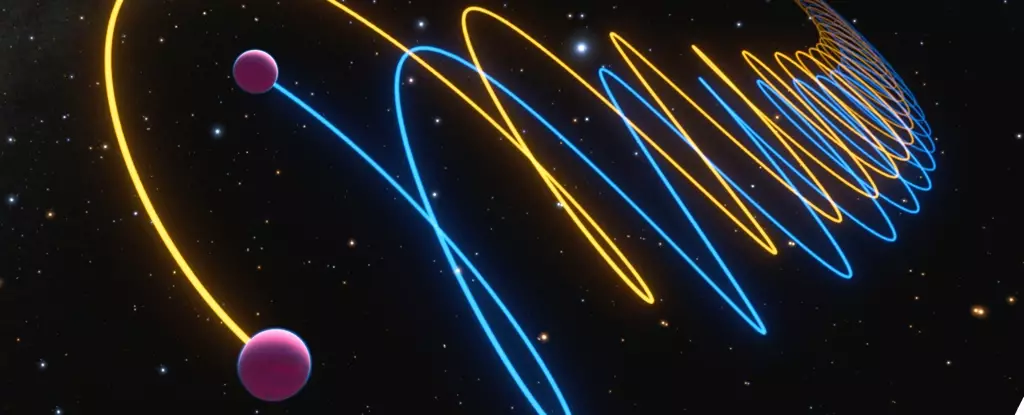In the realm of astronomy, the discovery of celestial bodies often generates waves of curiosity and excitement. One such discovery occurred in 1995 when researchers from Caltech’s Palomar Observatory observed a peculiar object orbiting the red dwarf star Gliese 229, located approximately 19 light-years away from Earth. Initially identified as a brown dwarf, Gliese 229 B captured the imagination of astronomers for nearly three decades due to its unexpected dimness in relation to its mass. Weighing in at about 70 times that of Jupiter, one would expect this celestial object to emit a much brighter light. However, this puzzling outcome led scientists to delve deeper into its characteristics.
This journey into the cosmos was propelled by an international collaboration of astronomers led by Jerry W. Xuan, a graduate student at Caltech, alongside Dimitri Mawet, the David Morrisroe Professor of Astronomy. Their combined efforts included contributions from prominent institutions like the National Research Council of Canada and NASA’s Jet Propulsion Laboratory, creating a multidisciplinary approach to this astronomical enigma. Such collaborations enrich our understanding and bring together diverse expertise, allowing scientists to tackle complex questions regarding celestial phenomena.
The latest findings, recently published in the journal *Nature*, offer a fascinating twist to the Gliese 229 B narrative. It turns out that this object is not just a single brown dwarf but a binary system composed of two closely orbiting brown dwarfs, designated as Gliese 229 Ba and Gliese 229 Bb. This revelation challenges previous assumptions held by astronomers for nearly 30 years and speaks to the ongoing evolution of scientific inquiry. As Xuan eloquently states, “We just weren’t able to probe separations this close until now,” underscoring the advancements in observational technology that made this discovery possible.
To unravel the mystery surrounding Gliese 229 B, astronomers employed the GRAVITY interferometer located at the European Southern Observatory’s Very Large Telescope in Chile. This sophisticated instrument allowed the team to spatially resolve the two brown dwarfs and confirm their distinct spectral signatures. Moreover, by utilizing the CRyogenic high-resolution InfraRed Echelle Spectrograph (CRIRES+), they were able to measure the Doppler shift, further providing evidence for the binary nature of Gliese 229 B. These observations not only clarify the characteristics of Gliese 229 B but also represent a significant milestone in the evolution of astronomical research.
The findings indicate that Gliese 229 Ba and Bb have impressive masses of approximately 38 and 34 times that of Jupiter, respectively. Orbiting each other every 12 days and maintaining a separation of about 16 times the distance from Earth to the Moon, these brown dwarfs align perfectly with theoretical expectations for their luminosity. Mawet’s assertion that this discovery resolves the long-standing tension between mass and brightness emphasizes the significance of the findings. Furthermore, this breakthrough raises intriguing questions about the formation mechanisms of binary brown dwarfs.
It has been theorized that these pairs could form from the fragmentation of a star’s protoplanetary disk. In this context, gravitational interactions could lead to two brown dwarf seeds becoming bound to each other following a near encounter. This hypothesis invites further investigation, not just for brown dwarfs, but also for closely orbiting exoplanet binaries.
As the dust settles on this monumental discovery, astrobiologists and planetary scientists are afforded an exciting new realm of inquiry. The implication that we could potentially locate similar binary systems elsewhere in the universe opens numerous doors for exploration and understanding. Rebecca Oppenheimer, part of the original team that discovered Gliese 229 B, reflects on the implications of this revelation, noting that these twin brown dwarfs would appear quite strange in our night sky, emphasizing their fascinating divergence from our solar neighborhood.
With plans to search for more brown dwarf binaries using advanced tools such as the Keck Planet Imager and Characterizer (KPIC) and the High-resolution Infrared Spectrograph for Exoplanet Characterization (HISPEC), the quest for knowledge continues. Research efforts, spearheaded by Xuan and his colleagues, are laying the groundwork for future discoveries that could reshape our understanding of the cosmos and the entities dwelling within it.
The journey of Gliese 229 B from an enigmatic single brown dwarf to a distinctive binary system epitomizes the dynamic nature of scientific research. Through collaborations, advancements in technology, and unwavering curiosity, astronomers are not only uncovering the mysteries of distant worlds but also reconfiguring the very frameworks through which we understand the universe.


Leave a Reply